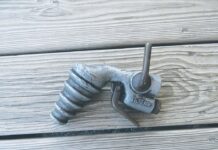Few habitats seem as sterile as a sandy New Jersey beach.
Waves of salt water constantly wash the shoreline. The only obvious indicators of life are pieces of broken shells washed ashore by the last high tide.
But appearances can deceive.
Plenty
The biota on a sandy beach can’t compare to a tropical rain forest, but to a careful observer, there’s plenty of life.
The shallow waters along the shore teem with microscopic algae, seaweed, small fish, and even an occasional dolphin or sea turtle.
But the tidal zone, the area between low and high tide, is much easier to observe and study. And after a few days of baking in the sun reading trashy novels, a lesson in beach biology is a welcome break.
Going beyond
During my recent summer vacation, I decided to look beyond the broken shells for signs of life.
The first order of business for a serious beach biologist is to get a tide chart, because the best beachcombing comes after high tide. It leaves behind a strip of biological debris called the wrackline.
Consisting primarily of seaweed, the wrack provides a moist habitat for small shrimp-like crustaceans called amphipods that are commonly called beach fleas or beach hoppers. The wrack also contains shells, skeletons, and sometimes entire dead bodies of many of the invertebrates that live just beyond the tidal zone. In death, they wash ashore.
Clams, oysters, mussels, and scallops are among the most common shells you’ll find.
Mesmerizing
My favorite spot on the beach is the swash zone where the waves lap the sand in a never-ending, mesmerizing rhythm.
Here a curious naturalist finds many signs of life. Among the most abundant are coquina clams. They are small, barely a half-inch long, brightly colored, and can occur in densities of thousands per square yard.
At a glance, coquinas seem at the mercy of the tide, but a few minutes of observation reveal that they use the waves to move up and down the beach.
Ideally, coqinas live in the top inch of sand. They anchor themselves in the sand with a small muscular “foot” and extend a tubular siphon to the water. Through the siphon, they filter single-celled diatoms from the water.
When disturbed by beachcombers or rough surf, coquinas ride to the surf line and anchor themselves to a new position. Coqinas move constantly as the tide ebbs and flows. This continual tidal migration, combined with their incredible numbers, insures that crabs and shorebirds don’t eat them all.
Many coquinas live symbiotically with hydroid colonies. These hydroids appear as tiny brown bushes that attach to the top end of buried coqina shells. The hydroids tentacles give away the location of buried coquinas, but their stinging ability may discourage predators. (These tentacles are tiny and harmless to people.)
Going digging
Another common swash zone creature is the mole crab, also harmless.
About an inch long, these small crustaceans are incredible diggers. When exposed to the surf, they latch onto the sand and disappear in a second or two. They burrow backwards beneath the sand until just their feathery antenna and eyestalks are exposed.
The antennae filter algae and other organic matter from the water and transfer it to the mouthparts.
Like a ghost
An early morning walk on the beach just after high tide reveals evidence of another amazing crustacean — the ghost crab.
Holes about an inch in diameter pepper the sand above the wrackline. These are the burrows of ghost crabs, small sandy colored crabs that are surprisingly difficult to see even when they scurry from one burrow to another.
Ghost crabs represent cryptic coloration at its best. At night, ghost crabs hunt the water’s edge for coquinas and mole crabs.
A variety of gulls and terns visit sandy beaches all day long, and early in the morning and after the crowds thin at dinner time, sandpipers and plovers play tag with the lapping waves as they forage in the swash zone.
For more information about life on east coast beaches, consult a terrific new book by Scott Shumway: Atlantic Seashore: Beach Ecology from the Gulf of Maine to Cape Hatteras (2008, $24.95, Globe Pequot Press).












